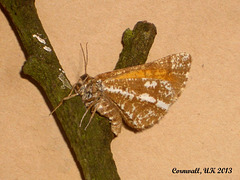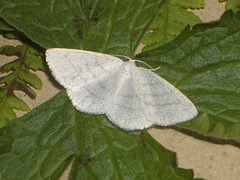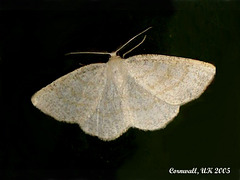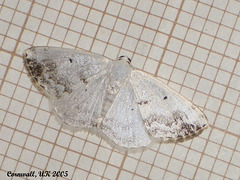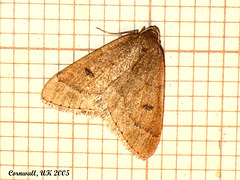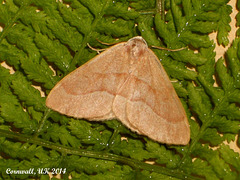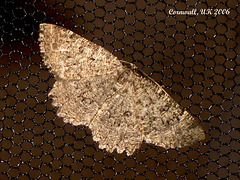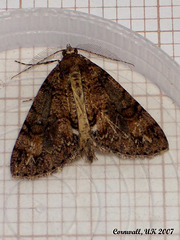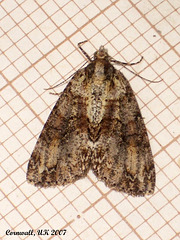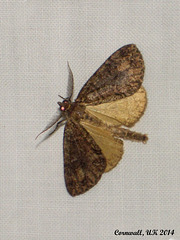
Cornwall Moths: Geometridae
Folder: Moths in Cornwall UK
A big update to Cornwall Geometridae, with a lot more species now illustrated. A few more have yet to be photographed for a reasonable reference picture, so hopefully they will be added through 2016. However, it will depend on whether we can record them in the right places at the right time of the year. Only time will tell.
This album lists the different species I've recorded over the years in th…
(read more)
1954 Bupalus piniaria (Bordered White)
| |
|
Geometridae, Ennominae Wingspan: 34-38mm.
A common species throughout the UK, but restricted to Pine woodland and plantations. In Cornwall, it is not seen very often, possibly due to under-recording in suitable habitats. The natural stance for this species is with wings together over the back, like a butterfly. Fortunately, this species has a distinctive brown underside with a prominent radial white stripe bisecting the hindwings and scattered white blotches against the background. The upperside has broad dark borders around the central wing areas, which can range from white to orange.
The flight season in the UK is defined as May / June, but the few records in west Cornwall so far occurred as occasional single individuals in May and July. The female shown above actually laid a number of eggs, but the young larvae which hatched refused to feed on the pine species available for some reason.
1955 Cabera pusaria (Common White Wave)
| |
|
Geometridae, Ennominae Wingspan: 30-34mm.
A common species distributed throughout the UK, and widespread in Cornwall. One of two similar species, but they are usually easy to tell apart. Overall, the colours are a white background with three grey lines crossing. It is somewhat similar to 1956 Common Wave, but the cross lines on the forewings of this species are almost straight whereas the Common Wave lines are markedly curved.
The flight season in southern UK is defined as two generations, May / June, and late July / August. In Cornwall, it is more a broad peak centring June / July with no obvious dip in the population. Also, it is extended with individuals appearing in April and September.as well.
1956 Cabera exanthemata (Common Wave)
| |
|
Geometridae, Ennominae Wingspan: 28-32mm.
Another common species seen throughout the UK and widespread in Cornwall. One of two similar species, which are fairly easy to identify unless faded. Against the white background, this species has a peppering of brown scales all over, and the three cross lines are also brown, and curved inwards.
Like 1955 Common White Wave, the flight season is made up of two overlapping generations May / early July, and July / September making a broad season. In Cornwall, they can often be seen in April.
1957 Lomographa bimaculata (White-pinion Spotted)
| |
|
Geometridae, Ennominae Wingspan: 26-28mm.
A common species in the south and west central UK, and widespread in Cornwall. A generally unmistakable species, except that if badly faded the forewing spots might be missing or very faint.
The flight season in most areas is May / early July, but as in Cornwall, they often fly in April as well.
1958 Lomographa temerata (Clouded Silver)
| |
|
Geometridae, Ennominae Wingspan: 26-30mm.
A common species distributed mainly to the central and southern areas of the UK, and widespread throughout Cornwall. A distinctive species, with the dark areas of the forewings usually visible in some form. Worn or faded specimens can be confused with similarly worn 1957 white-pinion Spotted.
The general flight season quoted for the UK is May to early July, but in Cornwall it has a much wider season, individuals being seen in April, and in reducing numbers from July to as late as December.
1960 Theria primaria (Early Moth)
| |
|
Geometridae, Ennominae Wingspan: 28-34mm.
A common species mainly restricted to central and southern areas in the UK, which may be under recorded at times.
The flight season in the UK is defined as January / February, with a possibility of extension into March. In Cornwall the flight season also includes April, with occasional individuals being seen in May and June.
1961 Campaea margaritata (Light Emerald)
| |
|
Geometridae, Ennominae Wingspan: 36-52mm.
A common species throughout the UK, and widespread in Cornwall. Not associated with the other species of "Emeralds", it has inevitably been named after those. A large and beautiful species, especially when freshly emerged, but in time can be found almost white due to fading.
The UK flight season is defined as late May to early August with occasional extensions into September in the south. In Cornwall, like in Scotland, there appears to be a distinct second generation with adults peaking again in September and into October. Late individuals are often much smaller than the main generation. An isolated individual was recorded in March in 2011, possibly due to mild conditions.
1962 Hylaea fasciata (Barred Red)
| |
|
Geometridae, Ennominae Wingspan: 34-42mm.
Another common species throughout the UK, and widespread but not quite as common in Cornwall. The smooth red cross-bar outline on the forewings serve to separate it from the similar 1903 Barred Umber. Contrary to the common name, some males of this species can appear in a dull green form (H.f.prasinaria), although this is rare in the UK and more common in Europe.
The flight season in the UK is defined as mid June to early August, but occasional individuals in May and October have been recorded in Cornwall.
1964 Charissa obscurata (Annulet)
| |
|
Geometridae, Ennominae Wingspan: 30-36mm.
A locally distributed species throughout the UK usually found in coastal areas. It is only occasionally recorded in Cornwall, and generally towards the west of the county. A quite variable species, which is said to match the colouration of soil and rocks in its habitat. The Cornwall specimens are generally quite dark, often obscuring the wing markings, but the aid to identification is the prominent indentations around the wing edges.
The flight season in the UK is shown as July / August, although in Cornwall individuals have been seen in June and September as well.
1965a Pseudocoremia suavis (1st specimen discovere…
| |
|
Geometridae, Ennominae Wingspan: 32-34mm.
In Cornwall, because of the high incidences of migrants, we tend to expect unusual species appearing occasionally, but this individual (the first) which came to my garden light trap in April 2007 created quite a problem. No-one knew what it was, even experts in Europe, so a lengthy investigation started. Three months later, in July, another strange quite different individual came in increasing the confusion. This continued through the year with widely separated specimens into October, until I had 5 altogether, with three different forms, but at least some were similar. It wasn't until 2008, that the Natural History Museum in London finally identified that they were all a species which was known in New Zealand, and explained the confusion with my specimens, as this species is extremely variable. Over the years, I have continued to get occasional specimens coming to the trap, which suggested a now resident population somewhere nearby, but not likely very close. My feeling is that this species has been imported somewhere on plants from New Zealand by a large Plant Importer, and since then some of its stock has now been distributed for gardens, inadvertently passing the larvae around the UK on some of them. Our area is quite remote, and there are no Importers anywhere in the Cornwall area, so we have no idea how it has come into the country. Possibly there are other populations elsewhere which have not yet been recognised as the variants of this species are often similar to other resident species, so could be overlooked. Since the first specimen a few other recorders have also seen them in the area as well, one of which was around 3 Km from here, so they may be spreading as well. I have included a number of different forms in the other pictures in this album to show the variety, and then, after getting eggs successfully from one of the females, I managed to rear these through their stages. Pictures are shown in the "Rearing Cornwall Moths" album.
1965a Pseudocoremia suavis (2nd Specimen) Female
| |
|
Geometridae, Ennominae Wingspan: 32-34mm.
In Cornwall, because of the high incidences of migrants, we tend to expect unusual species appearing occasionally, but this individual (the Second) which came to my garden light trap in July 2007 continued the problem. No-one knew what it was, even experts in Europe, so a lengthy investigation started. This continued through the year with widely separated specimens arriving into October, until I had 5 altogether, with three different forms, but at least some were similar. It wasn't until 2008, that the Natural History Museum finally identified that they were all a species which was known in New Zealand, and explained the confusion with my specimens, as this species is extremely variable. (See the first specimen picture notes for more detail)
1965a Pseudocoremia suavis (6th specimen) Female
| |
|
Geometridae, Ennominae Wingspan: 32-34mm
This individual (the Sixth) which came to my garden light trap in June 2009 Showed a new form, and that more were in the area. It wasn't until 2008, that the Natural History Museum finally identified that they were all a species which was known in New Zealand, and explained the confusion with my specimens, as this species is extremely variable. (See the first specimen picture notes for more detail)
1965a Pseudocoremia suavis (13th Specimen) Male
| |
|
Geometridae, Ennominae Wingspan: 32-34mm
This individual (the 13th) which came to my garden light trap in August 2014 showed that more were still in the area. It wasn't until 2008, that the Natural History Museum finally identified that they were all a species which was known in New Zealand, and explained the confusion with my specimens, as this species is extremely variable. (See the first specimen picture notes for more detail)
1970 Perconia strigillaria (Grass Wave)
| |
|
Geometridae, Ennominae Wingspan: 30-40mm
A locally distributed species probably to the south of the UK but restricted to lowland Heathland. In Cornwall, there are only two areas where it has been recorded to the west of the county, and numbers seen are far from plentiful. It can be seen in the daytime, or will come occasionally to a light trap.
The flight season in the UK is defined as May to July, but in Cornwall it has only been recorded in June.
Jump to top
RSS feed- Latest items - Subscribe to the latest items added to this album
- ipernity © 2007-2024
- Help & Contact
|
Club news
|
About ipernity
|
History |
ipernity Club & Prices |
Guide of good conduct
Donate | Group guidelines | Privacy policy | Terms of use | Statutes | In memoria -
Facebook
Twitter

